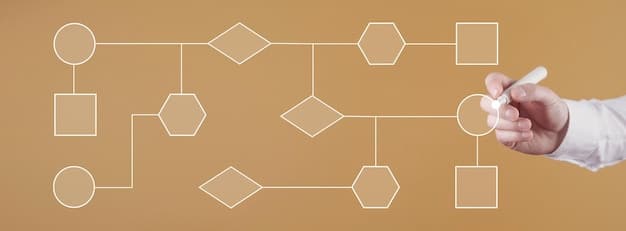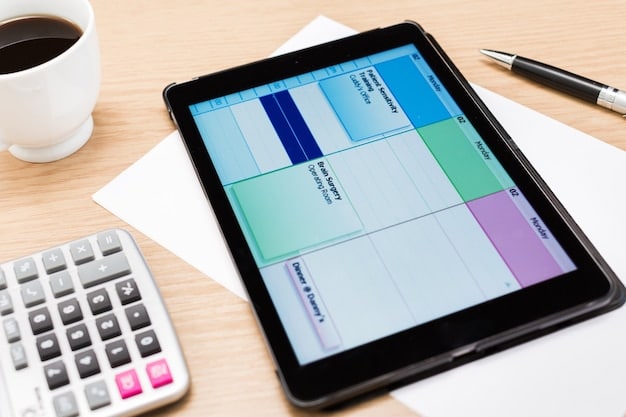Master the GTD Method: Organize Tasks & Reduce Stress

The Getting Things Done (GTD) method is a powerful approach to productivity that helps you organize tasks, manage commitments, and reduce stress by providing a clear system for capturing, processing, organizing, reviewing, and doing.
Feeling overwhelmed by endless to-do lists and competing priorities? Discover how the Getting Things Done (GTD) method: Organize Your Tasks and Reduce Stress can transform your workflow and bring tranquility to your daily life.
Understanding the Getting Things Done (GTD) Method
The Getting Things Done (GTD) method, created by David Allen, is more than just a to-do list; it’s a comprehensive system for managing your workflow, commitments, and projects. It provides a structured approach to productivity that emphasizes clarity, control, and focus.
GTD is about getting everything off your mind and into a trusted system so you can focus on the task at hand. This method helps you to organize your thoughts, prioritize tasks, and ultimately, reduce stress.

The Five Core Principles of GTD
- Capture: Collect everything that grabs your attention.
- Process: Decide what each item is and what to do with it.
- Organize: Put items where they belong in your system.
- Review: Frequently look over your system to keep it current.
- Engage: Simply do.
By following these five principles, you create a reliable system that promotes clarity and focus, freeing you from the mental clutter that often leads to stress and inefficiency.
In essence, GTD provides a framework for making clear, actionable decisions about everything that commands your attention, ensuring that nothing falls through the cracks.
Setting Up Your GTD System: Capture
The first step in the Getting Things Done (GTD) method is to capture every task, idea, project, and commitment that you need to track. This ensures that nothing is forgotten, allowing you to clear your mind and focus on what’s important.
Capture everything, big or small, personal or professional. Don’t worry about organizing it at this stage; the goal is simply to get all your “stuff” out of your head and into a trusted system.
Tools for Capturing Your Tasks
You can use a variety of tools to capture your tasks and ideas. Find what works best for you. Some popular options include:
- Physical Inbox: A physical tray or basket for collecting paper-based items.
- Digital Inbox: Email inboxes, note-taking apps, or task management software.
- Voice Recorder: For capturing ideas and tasks on the go.
The key is to have a centralized, easily accessible location for collecting everything that needs your attention. Regular dumping of your mind and into your trusted system clears up mental clutter. From the trusted system, you move to the next process: processing.
Once you’ve decided on a capture method, make it a habit to regularly empty your mind and input everything into your capture system. This will help you stay organized and in control.
Processing Your Inbox: From Chaos to Clarity
Once you’ve captured all your tasks and ideas, the next step is to process your inbox. Processing involves making decisions about each item and determining what action, if any, is required.
This is where you move from collection to action which is a critical stage in the Getting Things Done (GTD) method as it transforms the raw data into actionable steps.
Questions to Ask When Processing
- What is it? Identify the item clearly.
- Is it actionable? Can you do something about it?
- If no, is it trash, reference, or something to incubate?
Processing efficiently involves a series of quick decisions that keeps your inbox manageable. Remember, the goal here is to clarify and define each item so you can move onto the next stage.
The processing stage is where you transform your random input into a set of actionable steps, turning chaos into clarity and ensuring that you’re only focusing on what truly matters.
Organizing Your Tasks: Creating a System That Works
After processing your inbox, the next step is to organize your tasks into a system that works for you. A well-organized system helps you to prioritize tasks, manage projects, and stay on top of your commitments.
Organizing involves categorizing and filing each item so that it’s easy to find and act upon. This will give you more confidence that you aren’t missing out on anything.

Key Components of an Organized GTD System
A robust GTD system includes several key components:
- Projects: Lists of related tasks working toward a specific outcome.
- Next Actions: The very next physical, visible activity to move a project forward.
- Waiting For: A list of things you’re waiting on from others.
- Someday/Maybe: Ideas or projects you might want to pursue in the future.
A good organizational system also involves assigning tasks to appropriate categories and contexts, so you can easily find what you need when you need it.
By organizing your tasks effectively, you create a clear, actionable overview of everything you need to do and will empower you to stay focused, motivated, and in control.
Reviewing Your System: Maintaining Control and Focus
Regular review is a cornerstone of the Getting Things Done (GTD) method. A routine review helps you to keep your system up-to-date, identify potential roadblocks, and adjust your priorities as needed.
This review will make sure everything is current which in turn enables you to maintain control, confidence and focus.
Elements of a Successful GTD Review
- Clear Your Head: Recapture any new tasks or ideas.
- Update Your Lists: Review and update your project and task lists.
- Look Ahead: Review your calendar and upcoming commitments.
Regular review also sets the stage for effective action, clarifying what needs to be done and when so you can make informed decisions about how to allocate your time and energy.
By integrating regular review into your routine, you will maintain a clear, up-to-date overview of everything you need to do and increase your ability to stay focused, adapt to change, and achieve your goals with confidence.
Engaging: Taking Action and Getting Things Done
The final step in the Getting Things Done (GTD) process involves taking action and getting things done. This means choosing the right tasks at the right time and focusing your energy on completing them efficiently.
Knowing that everything is processed, organized, and regularly reviewed, you can trust the choice you make about what to do at any given moment.
Factors to Consider When Choosing Actions
- Context: What resources or locations are available to you?
- Time Available: How much time do you have to dedicate to a task?
- Energy Available: How much energy do you have to invest in a task?
By considering these factors and choosing tasks accordingly, you can ensure that you’re making the most of your resources and maximizing your productivity.
Ultimately, the engaging stage is where you experience the true power of GTD, transforming your organized thoughts and intentions into real-world accomplishments.
| Key Point | Brief Description |
|---|---|
| 📦 Capture | Collect all your tasks and ideas into an inbox. |
| ⚙️ Process | Decide what each item is and what to do with it. |
| 🗂️ Organize | Put items where they belong in your system using lists and categories. |
| 🎯 Engage | Take action on your tasks, choosing the right things at the right time. |
Frequently Asked Questions (FAQ)
▼
The main goal is to achieve stress-free productivity by systematically organizing tasks and commitments. GTD helps clear the mind and focus on actionable items.
▼
Ideally, conduct a weekly review to update lists, set priorities, and plan for the upcoming week. Daily reviews can help maintain focus and manage immediate tasks.
▼
Yes, many digital tools work well with GTD. Task management apps, note-taking software, and calendar apps can all be integrated into your GTD system.
▼
Periodically review your “Someday/Maybe” list and prune it. Remove items that no longer interest you or align with your goals to keep the list manageable and relevant.
▼
Break large projects into smaller, actionable tasks. Define the next action for each project to keep making progress, and regularly review the project’s status.
Conclusion
By implementing the Getting Things Done (GTD) method, you can transform your approach to productivity, reduce stress, and achieve a greater sense of control over your life. From capture to engage, each step plays a crucial role in creating a seamless workflow that empowers you to get things done effectively and efficiently.





